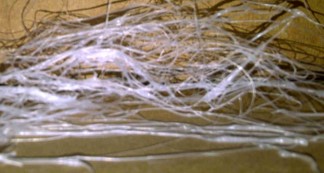GOT STRING? Not all string is good string when it comes to hot melt!

Stringing is a common problem when using hot melt adhesives. It can be from the nozzle, from the substrate, seen as cobwebs, etc. Stringing can cause nozzle misfires if build-up is severe on nozzle. When it builds-up on equipment, adhesive can smear on outer packaging, cause pop-opens, machine jams, interfere with photo eyes, etc.
Possible Cause – Temperature Too Low
Do not shock the system, melt tank should be at least 50% full of molten adhesive.
Hoses and guns cannot keep up with the low temperature
Maintain same setting for tank, hose, and gun. Check with equipment manufacture for recommendation. Gun may be set 5-15°F higher for better cut-off.
System work better when the tank does the bulk of the heating.
Insure temperature controls are operating properly.
Check with OEM if system is malfunctioning.
Remove air drafts from area.
Drafts of cold air causes adhesive to cool rapidly.
Make sure hoses are not touching floor.
Cold floor will act as a heat sink.
Possible Cause – Low Air Pressure
Raise air pressure but DO NOT EXCEED 50 PSI. Check with equipment manufacture.
Low Pressure isn’t enough to activate gun properly
Ensure pressure gauge is working properly.
Decrease air pressure if exceeding 50 PSI – if needing pressure this high, check filters and check nozzle clogs.
Cob-webbing and stringing can be due to adhesive splashing as well.
Substrate is too far from gun:
Distance between gun and substrate should not exceed 1 inch.
The further the adhesive has to travel, the more change for stringing.
Poor nozzle shut-off:
Clean nozzle. Check filters. Replace if needed.
Char can clog nozzles.
Viscosity too high:
Raise temp but do not exceed recommended application temperature.
Higher temps will degrade adhesive faster.
Hot melt too tacky:
Raise temp to decrease hot tack – do not exceed recommended application temperature.
Adhesive degradation:
Drain adhesive and replace with fresh adhesive.
Oxidation will occur over time, creating char and viscosity instability.
CGM would like to thank Joe and H.B. Fuller for their contribution to our blog and for the recommended procedures to help eliminate stringing.















